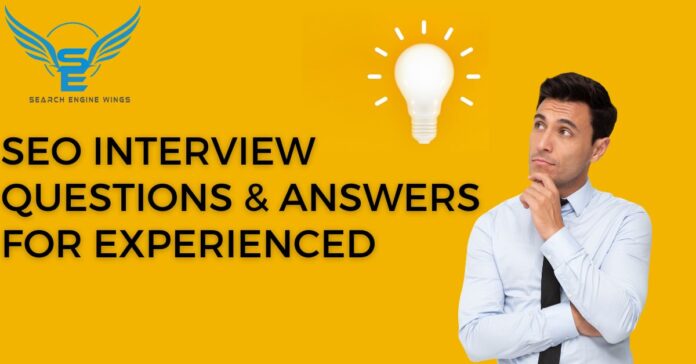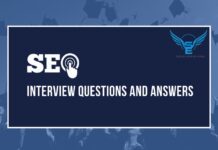On-Page SEO
Question 1. How can meta tags be made more effective for on-page SEO?
Answer: In the meta title and description, organically incorporate the desired term. Maintain short meta titles (60 characters) and informative meta descriptions (160 characters). Make sure the meta title and description for each page are distinct. To boost clicks from search results, use engaging language.
Question 2. How can keyword optimization for on-page SEO be done without going overboard?
Answer: Conduct extensive keyword research to find high-traffic, relevant keywords. In the page title, meta description, and the opening sentence of the text, use the main keyword. Synonyms and associated keywords should be naturally incorporated throughout the article. To avoid keyword stuffing, aim for a keyword density of 1% to 2%. Put the user experience first while producing useful, top-notch material.
Question 3. Why is internal linking crucial for on-page SEO and how should you go about it?
Answer: Internal linking is directing users from one page of a website to another within the same domain. In on-page SEO, it’s significant because it improves user experience by making navigation easier and providing other pages links equal opportunity, which raises their search engine results. It makes information more manageable for search engines to find and index content more effectively. Building the site’s subject relevance and semantic connection.
Question 4. Describe the concept of on-page user intent optimization.
Answer: The goal of user intent optimization is to match the content of a webpage with the purpose of a user’s search query. It entails figuring out whether the user is looking for data, wants to buy something, or wants to take a certain action. You can enhance conversions, lower bounce rates, and improve engagement by presenting content that is relevant to user intent. For seasoned practitioners, these questions and answers address crucial on-page SEO subjects. Keeping up with industry trends and algorithm updates is essential for success in this business because the SEO landscape is continuously changing.
OFF-Page SEO
Question 1. How should link-building be approached in an off-page SEO plan?
Answer: Link building that works involves:
- locating authoritative websites that are relevant to your niche.
- developing useful, shareable content.
- reaching out to bloggers or website owners to request a link placement.
- making sure to use appropriate anchor text.
- keeping an eye on and preserving the caliber of backlinks earned.
Question 2. How should anchor text be optimized? What role does it play in off-page SEO?
Answer: Anchor text is important since it informs search engines about the context of the linked page’s content. Make sure the anchor text is pertinent, detailed, and contains the desired keywords. For a natural link profile, stay away from over-optimization and use a range of anchor texts.
Question 3. How should anchor text be optimized? What role does it play in off-page SEO?
Answer: Anchor text is important since it informs search engines about the context of the linked page’s content. Make sure the anchor text is appropriate, detailed, and contains the desired keywords. For a natural link profile, stay away from over-optimization and use a range of anchor texts.
Question 4. How do you spot uncertain backlinks in an off-page SEO effort and remove them?
Answer: Use resources like Google Search Console, SEO software, or manual examination to find dangerous backlinks. To preserve your site’s ranking, create a disavow file and submit it through Google’s Disavow Links tool. This will ask search engines to ignore such links.
Technical SEO
Questions 1. How can crawl faults that were reported in Google Search Console be found and fixed?
In response, Google Search Console offers comprehensive information on crawl problems, including 404 and server errors. You should look into the underlying cause, address the problems, and, if needed, ask for reindexing to solve them. To keep a website in good condition, it’s crucial to constantly check for crawl issues.
Question 2. Why use a 302 redirect instead of a 301 redirect and what are the differences between the two?
Answer: An effective permanent redirect used after a webpage has relocated permanently to a new URL is known as a 301 redirect. The link equity is transferred to the new URL. A 302 redirect, which denotes that the change is temporary, is a redirect. 301 redirects are frequently used in SEO for page migrations or when you wish to combine several URLs into one.
Question 3. When should the “nofollow” property be used in SEO? What does it mean?
Answer: In order to tell search engines not to follow the link or send any link equity to the connected page, HTML links employ the “nofollow” tag. Use it when you don’t want to give certain external links authority, such as with user-generated content like comments.
SEO Tools and Analytics
Question 1. Which analytics and SEO tools do you have experience with?
Answer: Mention any additional relevant SEO software you have used, along with tools like Google Analytics, Google Search Console, Moz, SEMrush, and Ahrefs.
Question 2. What KPIs are monitored and how are SEO campaigns evaluated for success?
Answer: KPIs like organic traffic, keyword ranks, click-through rates, conversion rates, and revenue from organic search can all be used to gauge the performance of SEO campaigns. The campaign’s objective will choose which KPIs to use.
Algorithm And Updates
Question 1. The Google Penguin update should be described. What impact did it have on link-building techniques?
Answer: Google Penguin, which debuted in 2012, targeted spammy link-building techniques such as cramming keywords into anchor text and using low-quality, irrelevant backlinks. Cleaner, white-hat link-building strategies had to be adopted by SEOs, stressing natural link profiles, guest blogging, and eschewing harmful connections.
Question 2. How has SEO been affected by the E-A-T (Expertise, Authoritativeness, and Trustworthiness) idea, especially in light of the Google Medic update?
Answer: The 2018 Google Medic update highlighted the significance of E-A-T. It needed SEOs to concentrate on establishing trustworthiness, creating authority, and displaying knowledge for websites, particularly those in the YMYL (Your Money or Your Life) categories.
Question 3. Talk about the Page Experience change and how it affects SEO user experience.
Answer: The Core Web Vitals (loading performance, interaction, and visual stability), which were user experience characteristics, became crucial ranking signals with the Page Experience upgrade, which was implemented in 2021. Prioritizing web page optimization for a better, more satisfying user experience was necessary for SEOs.
Local SEO
Question 1. How should local SEO for firms with many locations handle NAP consistency?
Answer: The Name, Address, and Phone Number (NAP) must be consistent throughout all web listings and directories. Use a consistent format across the website, GMB listings, social media profiles, and other online directories. Quickly update any changes.
Question 2. What KPIs (Key Performance Indicators) do you monitor to assess a local SEO campaign’s effectiveness?
Answer: Local search results, organic traffic, website conversions, click-through rates on Google My Business listings, client reviews and ratings, and foot traffic for brick-and-mortar businesses are all crucial KPIs.
Ethics and Best Practices
Certainly! In SEO, phrases like “white hat,” “grey hat,” and “black hat” are used to group various strategies and tactics utilized by practitioners. These classifications aid in separating questionable or immoral practices from undesirable ones. Here are descriptions of each with illustrations:
- White Hat SEO:
Definition: White hat SEO describes legitimate and moral optimization methods that follow search engine standards. These procedures center on giving consumers something of value and enhancing the trustworthiness and reputation of a website over time.
Examples:
- Quality material: Producing original, meaningful material that fulfills user purpose.
- Keyword optimization: It involves incorporating pertinent keywords naturally into text, meta descriptions, and headlines.
- Link building: It is the process of naturally obtaining backlinks from trustworthy and authoritative websites.
Making sure a website is user-friendly for mobile devices to improve the user experience.
- Black Hat SEO
Hat in gray, as stated SEO tactics fall somewhere between ethically questionable and unethical behavior. Although they might not directly contravene search engine policies, they could be viewed as manipulative or questionably moral.
Examples:
- Publishing guest posts on websites with little relevance or low-quality content is known as guest posting on low-quality websites.
- Using spectacular or deceptive titles to entice clicks is known as clickbait.
- Targeting the same keywords on different websites might cause search engines to become confused, which is known as keyword cannibalization.
- Gray Hat SEO
These strategies fall somewhere between white hat and black hat SEO. Although they might not directly contravene search engine policies, they could be viewed as manipulative or questionably moral.
Examples:
- Publishing guest posts on websites with little relevance or low-quality content is known as guest posting on low-quality websites.
- Using spectacular or deceptive titles to entice clicks is known as clickbait.
- Targeting the same keywords on different websites might cause search engines to become confused, which is known as keyword cannibalization.







